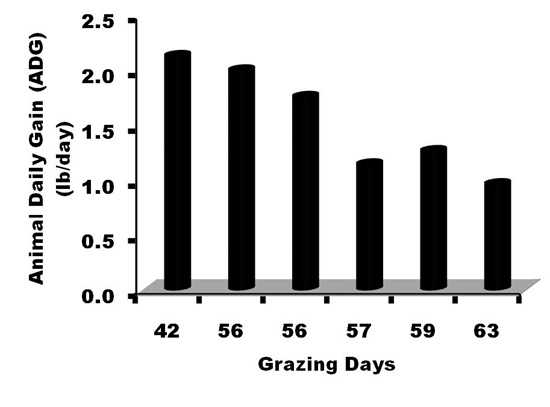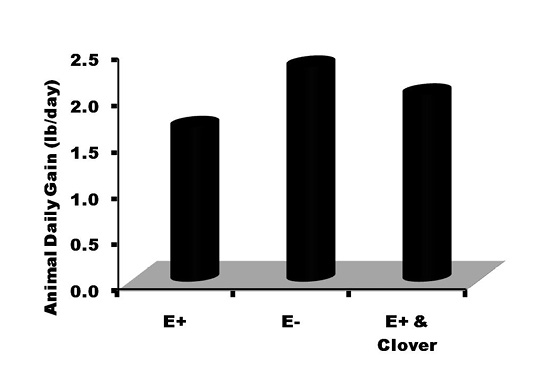Extending the Grazing Season: Stockpiled Tall Fescue
In Mississippi, one of the greatest expenses for cattle producers is winter feeding costs. One way to lower these costs is by stockpiling forages for winter grazing.
Tall fescue is a forage adapted to regions of Mississippi. You can stockpile it for late fall and early winter grazing. Its waxy leaves help preserve and protect it. Stockpiling allows you to extend the grazing season well beyond the growing season, reducing the demand for hay, silage, and other feed. In addition, under proper grazing of stockpiled tall fescue, cattle distribute manure more evenly over the pasture, returning nutrients to the soil.
Tall fescue is well-adapted to the soil and weather conditions of most areas of central and northern Mississippi. Most of the tall fescue in the state is toxic endophyte-infected (E+), but some producers are now renovating their pastures with non-toxic endophyte-infected (friendly-endophyte) cultivars. Endophyte-infected tall fescue is often more persistent than other perennial cool-season grasses because it is tolerant of dry, acidic, low-fertility soils. Tall fescue also resists trampling damage, even on wet winter soils.
Toxic endophyte, a fungus, produces chemicals that can poison grazing animals. The toxins can increase body temperatures, cause rough hair coats, and slow weight gain. Non-toxic endophyte-infected tall fescue provides the same benefits to the forage as the toxic type provides. However, it does not produce the same toxins. Non-toxic endophyte-infected tall fescue can be stockpiled in the fall for later winter grazing, reducing the cost of feeding hay.
When to Begin Stockpiling Tall Fescue
You should consider forage quality and yield when stockpiling tall fescue. You will have to decide when to begin stockpiling (last day of grazing or mechanical harvest), nitrogen application (date and rate), and the legume composition in the pasture. All of these factors affect the balance between yield and quality of stockpiled fescue. Stockpiling tall fescue should start from late August to late September. Before stockpiling, mow or closely graze fields. Remove livestock from the pasture.
Have a soil test run before stockpiling. The test will give recommendations for nutrients like phosphorus, potassium, and lime. Fertilize accordingly. Tall fescue should be allowed to accumulate growth until late November or early December when hay feeding usually starts.
Fertilization
Tall fescue is also very responsive to nitrogen (N) fertilizer, and high yields can be achieved with timely N application (Fig. 1). There are three primary factors that should be considered when fertilizing: soil moisture levels, type of fertilizer being used, and the time of application. Application of either inorganic [urea or ammonium nitrate (AN)] or organic nitrogen at the start of stockpiling grasses is essential. The nitrogen source will influence its use efficiency. Urea may be 79 to 89% as effective as ammonium nitrate on an equivalent nitrogen basis.
Nitrogen may be top-dressed 60 to 70 days before the end of the growing season at the rate of 40 to 60 lb N/ac along with phosphate (P2O5) and potash (K2O). Follow soil test recommendations. In autumn applications ammonia nitrate is usually more effective than urea is (Fig. 2). As figure 2 shows, the timing of the nitrogen application is important. Applying nitrogen too early may encourage the growth of certain weeds and therefore reduce the production of tall fescue. Applying nitrogen too late will reduce the quantity of stockpiled forage. Studies show that nitrogen is much more effective on tall fescue when you apply it in August instead of October (Fig. 3). September is a good time to apply nitrogen to tall fescue and begin stockpiling forage.
Moisture and temperature both affect nitrogen use efficiency. Soil must be moist enough for a reasonable level of forage. Avoid nitrogen applications on wet, hot days. The combination of high temperature and high moisture can cause nitrogen losses. Nitrogen losses could decrease yields and quality. Remember these management practices may need to be adjusted depending on your operation and location.



Management of Stockpiled Tall Fescue
To use stockpiled forage efficiently, you must manage grazing. Uncontrolled grazing may waste about 50 to 60 percent of the forage because of trampling and manure dropping on unused forage. The best way to use stockpiled tall fescue is by strip-grazing. Restrict access to a 3- or 7-day forage supply to increase the number of grazing days. To make the most efficient use of the high-quality feed in stockpiled fields, install a temporary electric fence across the field dividing it so the area to be grazed first has a source of water and minerals. Once the animals have grazed this area off, move the fence back, opening up a new strip. Repeat this system until the entire field has been grazed (Figure 4).
Depending on when you began stockpiling, fertilizer rate, rainfall, and livestock daily intake levels, it is possible to have 50 to 60 days of available forage. Because tall fescue holds its quality, graze any available crop residues (corn, soybean, cotton, or milo) first in the fall. Use stockpiled tall fescue later in the winter. If there is a difference in length of stockpiling period among pastures, begin grazing the oldest material first. If some areas have a significant amount of red clover, graze them early as well. Red clover deteriorates more rapidly than tall fescue.

Forage Quality and Nutrition
Stockpiled tall fescue loses about 25 to 30 percent of its dry matter over winter. The rate of dry matter loss does not depend on nitrogen rate or stockpile start date. Stockpiled tall fescue does not usually lose much quality; most losses are because of dry matter deterioration. The nutrition value may be able to support good livestock growth rates in developing cattle. Tall fescue loses soluble carbohydrates and potassium (K) because of absorption by the root system and leaf deterioration. The loss in carbohydrates can cause the forage to have more fiber and be less digestible. Green leaf and green stem decrease by about half from November to February. During the same time, biomass increases by about half (Figure 5). These changes are not directly related to the endophyte status or how long the tall fescue has been stockpiled.
Sugar content, protein, and digestibility could be acceptable from autumn to early winter (Figure 6). Crude protein concentrations tend to decrease in winter. Concentrations of NDF do not change because of the duration of stockpiling. IVDMD decreases from mid-December to mid-February.
Carbohydrate levels also decrease from December to February. Total energy decreases from November to March. Animals may avoid eating stockpiled tall fescue more than you might predict based on the change in digestibility. That choice may be caused by the decrease in soluble carbohydrates and the increase in fiber. In a study, the part of the forage that was in green leaf did not lose digestibility and gained lignin between November and December. The bit of stem in the sample group also did not lose digestibility and gained protein during stockpiling. The nutritional value of the dead material was low but did not change because of stockpiling. Give mineral supplements when grazing stockpiled tall fescue because the forage loses minerals as the winter progresses.
Fall-calving cows can benefit from stockpiled fescue. Animal average daily gain (ADG) in calves could be affected by the number of days in the grazing period. ADG may decrease as grazing period length increases (Figure 7). Endophyte status could also affect animal average daily gains (Figure 8). The highest gains on stockpiled fescue are from endophyte-infected grass. The presence of a legume such as red clover with stockpiled fescue will also increase animal gains.
Toxic endophyte-infected tall fescue produces poisons. By January, the levels of these toxins could decrease by up to half in stockpiled tall fescue. Another study found an 85 percent reduction in the toxin from October to March. In other words, if you graze toxic endophyte-infected tall fescue later in the winter, toxins will be lower. Nutritional value will also be lower.
Stockpiling tall fescue can extend the grazing season, reduce winter hay feeding needs, and provide a good return of high-quality forage. Select the optimum date and rate of nitrogen application to help maintain yield and quality of tall fescue. Controlled grazing management can also increase forage use.




References
Buckner, R.C. 1975. The season of the year affects nutritional value of tall fescue. Univ. of KY. Coop. Ext. Serv. AGR-44.
Campbell Sr., J.P. 2007. Stockpiled tall fescue and the fungal endophyte. USDA Bulletin.
Collins, M., and J.A. Balasko. 1981a. Effects of N fertilization and cutting schedules on stockpiled tall fescue. I. Forage yield. Agron. J. 73:803–807.
Collins, M., and J.A. Balasko. 1981b. Effects of N fertilization and cutting schedules on stockpiled tall fescue. II. Forage quality. Agron. J. 73:821–826.
Fribourg, H. A., and Bell, K. W. 1984. Yield and composition of tall fescue stockpiled for different periods. Agron. J. 76:929-934.
Johnson, G. and R. Smith. 2004. Stockpiling tall fescue. Crop and Soil Environmental News. Virginia Tech.
Kallenbach, R.L, G. J. Bishop-Hurley, M.D. Massie, G.E. Rottinghaus and C.P. West. 2003. Herbage mass, nutritive value, and ergovaline concentration of stockpiled tall fescue. Crop Sci. 43:1001-1005.
Lacefield, G., R. Smith, J. Henning, J. Johns, and R. Burris. 2006. Stockpiling for fall and winter pasture. Univ. of KY. Coop. Ext. Serv. AGR-162.
Murdock, Lloyd W. 1982. Agron. Notes 15.2.
Taylor, T.H., and W.C. Templeton, Jr. 1976. Stockpiling Kentucky bluegrass and tall fescue forage for winter pasturage. Agron. J. 68:235–239.
Publication 2461 (POD-04-23)
By Rocky Lemus, PhD, Extension/Research Professor, Plant and Soil Sciences.
The Mississippi State University Extension Service is working to ensure all web content is accessible to all users. If you need assistance accessing any of our content, please email the webteam or call 662-325-2262.



